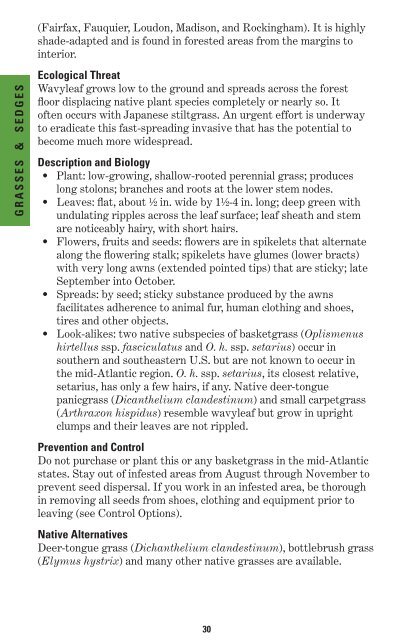Plant Invaders of Mid-Atlantic Natural Areas - National Park Service
Plant Invaders of Mid-Atlantic Natural Areas - National Park Service
Plant Invaders of Mid-Atlantic Natural Areas - National Park Service
Create successful ePaper yourself
Turn your PDF publications into a flip-book with our unique Google optimized e-Paper software.
GRASSES & SEDGES<br />
(Fairfax, Fauquier, Loudon, Madison, and Rockingham). It is highly<br />
shade-adapted and is found in forested areas from the margins to<br />
interior.<br />
Ecological Threat<br />
Wavyleaf grows low to the ground and spreads across the forest<br />
floor displacing native plant species completely or nearly so. It<br />
<strong>of</strong>ten occurs with Japanese stiltgrass. An urgent effort is underway<br />
to eradicate this fast-spreading invasive that has the potential to<br />
become much more widespread.<br />
Description and Biology<br />
• <strong>Plant</strong>: low-growing, shallow-rooted perennial grass; produces<br />
long stolons; branches and roots at the lower stem nodes.<br />
• Leaves: flat, about ½ in. wide by 1½-4 in. long; deep green with<br />
undulating ripples across the leaf surface; leaf sheath and stem<br />
are noticeably hairy, with short hairs.<br />
• Flowers, fruits and seeds: flowers are in spikelets that alternate<br />
along the flowering stalk; spikelets have glumes (lower bracts)<br />
with very long awns (extended pointed tips) that are sticky; late<br />
September into October.<br />
• Spreads: by seed; sticky substance produced by the awns<br />
facilitates adherence to animal fur, human clothing and shoes,<br />
tires and other objects.<br />
• Look-alikes: two native subspecies <strong>of</strong> basketgrass ( Oplismenus<br />
hirtellus ssp. fasciculatus and O. h. ssp. setarius) occur in<br />
southern and southeastern U.S. but are not known to occur in<br />
the mid-<strong>Atlantic</strong> region. O. h. ssp. setarius, its closest relative,<br />
setarius, has only a few hairs, if any. Native deer-tongue<br />
panicgrass (Dicanthelium clandestinum) and small carpetgrass<br />
(Arthraxon hispidus) resemble wavyleaf but grow in upright<br />
clumps and their leaves are not rippled.<br />
Prevention and Control<br />
Do not purchase or plant this or any basketgrass in the mid-<strong>Atlantic</strong><br />
states. Stay out <strong>of</strong> infested areas from August through November to<br />
prevent seed dispersal. If you work in an infested area, be thorough<br />
in removing all seeds from shoes, clothing and equipment prior to<br />
leaving (see Control Options).<br />
Native Alternatives<br />
Deer-tongue grass (Dichanthelium clandestinum), bottlebrush grass<br />
(Elymus hystrix) and many other native grasses are available.<br />
30

















